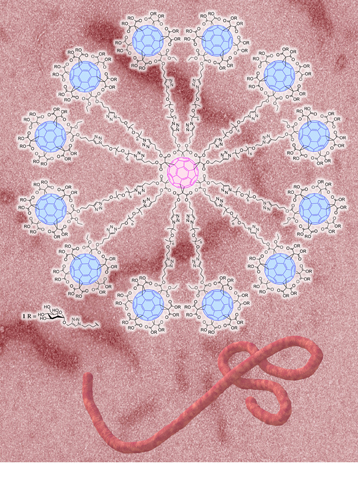The Ebola virus, just like the Dengue virus, uses the DC-SIGN receptors of our immune system’s dendritic cells. These cells, which are found in the blood and mucous membranes, can recognise the virus from its receptors. The virus commandeers the receptors to infect cells. Designing molecules that bind to the receptor with more affinity than the pathogen to block the virus is the most promising line of research.
Researchers from the Molecular Chemistry Laboratory (CNRS/University of Strasbourg) and from the Bioactive Molecule Design and Application Laboratory (CNRS/University of Strasbourg) are participating in an international collaboration among chemists, to find an effective treatment for the Ebola virus. Moreover, this work could lead to other treatments for other viruses using the same receptors to infect the organism. These researchers have developed a giant globular molecule that is water-soluble and non-toxic for cells in culture. This molecule inhibits the entry of the Ebola virus into cells very effectively. It is composed of a spherical molecule of 60 carbon atoms, a fullerene, onto which are fixed 12 branches. On each of the branches is a fullerene bearing 10 sugars.
This spherical molecule has the capacity to envelop the cell like a strip of Velcro®. The cell then becomes impermeable to pathogen agents. These compounds have already been tested in vitro and are 33% more effective than classic antivirals. This effectiveness is due in large part to the sugars surrounding the molecule.
As well as having created a molecule to actively fight the Ebola virus, the research team has also developed a very simple and fast synthesis method. They have managed to reduce the procedure to 6 steps instead of the twenty or so for more classic methods. This approach is called Click Chemistry. The researchers prepared fullerenes, each carrying 10 mannoses, and fixed them to a central fullerene.
Numerous stages still need to be carried out between the development of the method and in vivo tests. Trials on living subjects remain difficult to perform. There are still a number of years of research ahead before we’ll see medication against the Ebola virus flourish.

Synthesis of giant globular multivalent glycofullerenes as potent inhibitors in a model of Ebola virus infection, Antonio Muñoz, David Sigwal, Beatriz M. Illescas, Joanna Luczkowiak, Laura Rodríguez, Iwona Nierengarten, Michel Holler, Jean-Serge Remy, Kevin Buffet, Stéphane P. Vincent, Javier Rojo, Rafael Delgado, Jean-François Nierengarten et Nazario Martín. Nature Chemistry, 9 novembre 2015.
DOI : 10.1038/nchem.2387